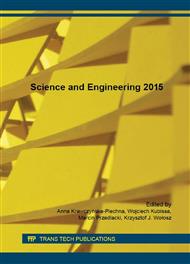p.88
p.96
p.101
p.108
p.115
p.125
p.131
p.137
p.145
Conception of FEM Analysis Using Special Multi-Area Plane State of Stress Elements
Abstract:
The idea of the special finite elements conception has been presented in the paper. The conception is based on the assumption that area of the structure with different stiffness and geometrical parameters is described by a single element. The idea of the special so-called “multi-area” plane state of stress (shield) elements is the application of modified shape functions. This modification is the use of broken shape functions in both horizontal and vertical direction of plane state of stress finite element. It is proposed to determine explicit form of stiffness matrix for the elements. This increases the computational efficiency compared to numerical integration. To simplify the final form of stiffness matrix, method of broken shape function “expanding” has been applied. The method of simplification of stiffness matrix explicit form has been tested in calculation examples and results have been presented in the paper.
Info:
Periodical:
Pages:
115-124
Citation:
Online since:
November 2015
Authors:
Keywords:
Price:
Сopyright:
© 2015 Trans Tech Publications Ltd. All Rights Reserved
Share:
Citation:


